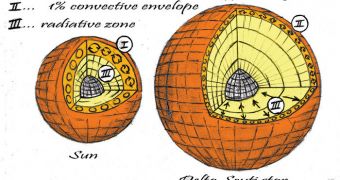A team of astronomers recently conducted a new study on a Delta Scuti star, a member of a class of special, pulsating celestial objects that can reach two solar masses. The work uncovered a previously-unsuspected process acting near the core of the star, influencing its appearance.
Solar physicists, in general, derive most of their information about any particular star from in-depth studies of their surfaces. Changes in brightness can reveal just as much new data about such an object as a probe implanted at its core.
In the case of Delta Scuti stars, things are especially interesting, considering that the main engine driving their pulsating mechanism is a phenomenon known as the kappa mechanism. Astronomers have known about this process for many years.
The brightness variations occur when highly-ionized regions below the solar surface begin to store massive amounts of energy. From time to time – when certain thresholds are reached – that energy is released through safety “valves,” making the entire star appear brighter on our radars.
What the new study uncovered was another mechanism that appeared to play a significant role in this as well. The research was conducted using the Kepler Telescope, a dedicated exoplanetary hunter can conducts its surveys via the transit method.
The observatory studied the Delta Scuti star HD 187547 for about a month, analyzing the slightest changes in brightness variation the object displayed. Astronomers learned that convective forces were still at work inside the star, despite its large mass.
“In the earlier days, astronomers measured variable stars by looking through telescopes and writing down the intensity, comparing it to standard stars, but those stars had large brightness changes,” University of Vienna astronomer Victoria Antoci explains.
“Only measurements from space telescopes such as Kepler are capable of providing the needed accuracy,” she adds, saying that the observatory's detectors saw variations that were one-millionth of what can be seen with the naked eye.
Details of the new study appear in the September 14 issue of the top scientific journal Nature. “We have now discovered the first star that shows both types of oscillation at the same time, slow and fast,” adds Gerald Handler, quoted by Space.
The expert, who is an astronomer at the Nicolaus Copernicus Astronomical Center in Warsaw, Poland, was a part of the new research. He concludes by saying that the next step in this research is to calculate the size of the star's core, as well as the number of layers it contains.

 14 DAY TRIAL //
14 DAY TRIAL //